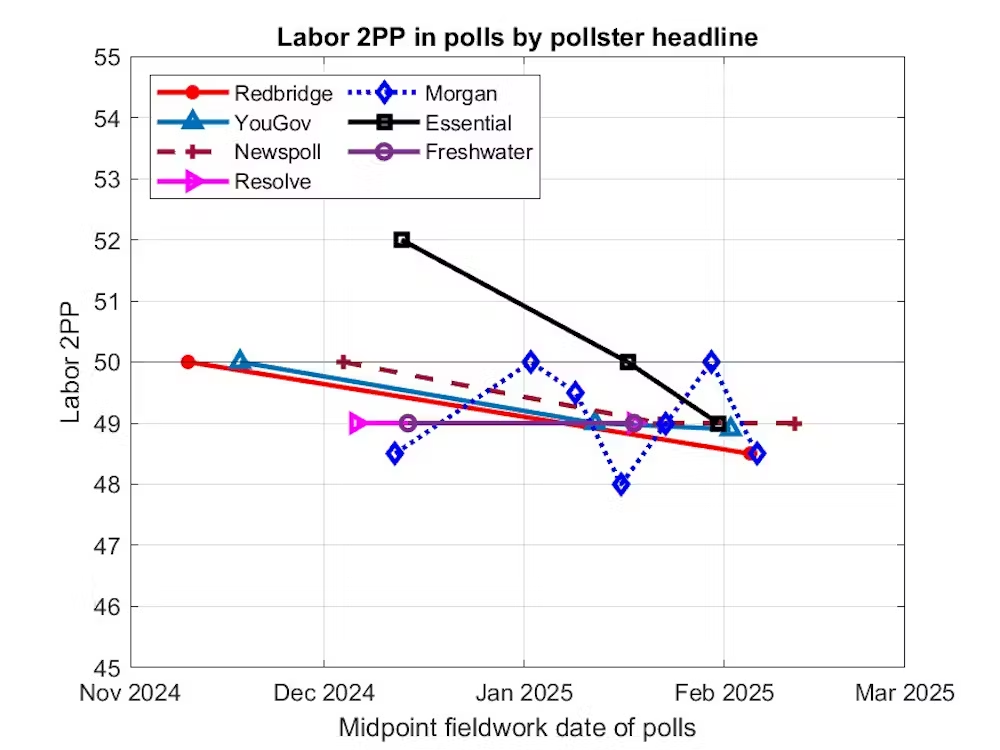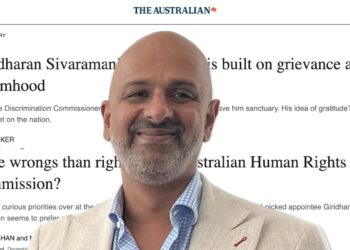Adrian Beaumont, The University of Melbourne
A national Newspoll, conducted February 10–14 from a sample of 1,244, gave the Coalition a 51–49 lead, unchanged from the previous Newspoll, three weeks ago. Primary votes were 38% Coalition (down one), 31% Labor (steady), 12% Greens (steady), 7% One Nation (steady) and 12% for all Others (up one).
Newspoll previously used 2022 election preference flows, but they have adjusted for stronger One Nation preferences to the Coalition at the Queensland state election. The one-point drop in the Coalition’s primary vote suggests Labor gained, but preference flow changes affected the unchanged two-party estimate.
The graph below shows Labor’s two-party vote for each pollster’s headline voting intentions. As the pollsters are making adjustments to the 2022 election preference flows, I don’t think it’s useful anymore to use the 2022 flows as a baseline.

I’ve revised some of the previous iterations of Morgan and Essential so they use their headline respondent preferences. The four new polls included since the last federal update are Newspoll, the YouGov MRP below and last week’s Morgan and Redbridge polls.
All polls have the Coalition leading by about 51–49. Labor had a better result (a 50–50 tie) from Morgan two weeks ago, but last week it reverted to a Coalition lead. Labor can recover this lead by the election that is due by May, but they’re currently losing.
In Newspoll, Anthony Albanese’s net approval slid one point to a new low of -21, with 58% dissatisfied and 37% satisfied. Peter Dutton’s net approval was up one point to -10. Albanese led Dutton by 45–40 as better PM (44–41 previously).
The graph below shows Albanese’s deteriorating ratings in Newspoll. The plus signs mark the data and a smoothed line has been fitted.

In more bad news for Labor, just 34% said they deserved to be re-elected, while 53% said it’s time to give someone else a go.
YouGov has Coalition winning the most seats
YouGov conducted a national MRP poll (multi-level modelling with post-stratification) from January 22 to February 12 from an overall sample of over 40,000. MRP polls are used to estimate the outcome in each House of Representatives electorate using huge samples and modelling.
YouGov’s central forecast if the election were held now is the Coalition winning 73 of the 150 lower house seats, three short of a majority. Labor would win 66 seats, independents eight, the Greens one and others two. At lower limits, the Coalition could win 65 seats and Labor 59, while at higher limits the Coalition could win 80 and Labor 72.
The overall vote share in this MRP poll was 51.1–48.0 to the Coalition, a 3.2% swing to the Coalition since the 2022 election. Primary votes were 37.4% Coalition, 29.1% Labor, 12.7% Greens, 9.1% One Nation, 8.9% independents and 2.8% others.
YouGov is using respondent preferences for its MRP polls, and it has a weakening of flows to Labor from both Green and One Nation voters compared with 2022. By 2022 election preference flows, this poll would be 50.2–49.8 to Labor.
Labor’s primary vote is down most in its once safe working-class seats. But the Coalition is not likely to regain any of the seats taken by teal independents at the last election.
Redbridge and Morgan polls
The Poll Bludger reported last Tuesday that a national Redbridge poll, conducted February 3–7 from a sample of 1,013, gave the Coalition a 51.5–48.5 lead, a 1.5-point gain for the Coalition since early November. Primary votes were 40% Coalition (up two), 31% Labor (down three), 11% Greens (steady) and 18% for all Others (up one).
Coalition supporters were more firm in their voting intentions (61% solid, 34% soft) than Labor supporters (51% solid, 39% soft). The poll suggested a 9% two-party swing against Labor in the outer suburbs, but this would have been based on a small subsample. Other swings were 5% against Labor in inner and middle suburbs, no change in provincial cities and a 3% swing to Labor in rural areas.

The Poll Bludger reported Sunday that a Redbridge and Accent Research poll of 20 marginal seats, conducted February 4–11 from a total sample of 1,002, gave the Coalition a 52–48 lead (51–49 to Labor across these seats in 2022). Primary votes were 43% Coalition, 33% Labor, 12% Greens and 12% for all Others.
A national Morgan poll, conducted February 3–9 from a sample of 1,688, gave the Coalition a 51.5–48.5 lead by headline respondent preferences, a 1.5-point gain for the Coalition since the January 27 to February 2 poll.
Primary votes were 40.5% Coalition (up two), 29% Labor (down one), 11% Greens (down 0.5), 4% One Nation (down 1.5), 9.5% independents (down one) and 6% others (up two). This is the lowest support for the Greens in this poll since November 2022. By 2022 election preference flows, the Coalition led by 51.5–48.5, a two-point gain for the Coalition.
UAP can’t register for election
Clive Palmer’s United Australia Party (UAP) voluntarily deregistered during this term, and were unable to re-register under this name. Palmer and the UAP’s only federal parliamentarian, Victorian Senator Ralph Babet, challenged this law, but the High Court last Wednesday denied the challenge.

Babet was elected in 2022 and won’t be up for election as his six-year term expires in June 2028. The coming election will be a normal one for the full House and half the Senate, not a double dissolution where all senators are up for election.
The UAP could still register under a different name, but their registration would need to be completed before writs are issued for the election. If the election is on May 17, the latest possible date, writs would need to be issued by April 14.
Victorian Labor retains Werribee at byelection
I previously covered the February 8 Victorian state byelections for Werribee and Prahran. On the election night count, Prahran was a Liberal gain from the Greens, with Labor ahead in Werribee but not certain to hold.
Over 2,000 additional postals have been counted in Werribee, and Labor increased its lead, and now leads by 50.8–49.2 against the Liberals, a 10.2% swing to the Liberals since the November 2022 state election.
Left-wing parties will do badly in Germany
I covered next Sunday’s German election for The Poll Bludger on Saturday. The conservative CDU/CSU and far-right AfD are the top two parties in the polls, with the governing centre-left SPD and the Greens trailing.
In Canada, Mark Carney is almost certain to be elected Liberal leader, replacing Justin Trudeau. In recent weeks, the Liberals have closed the gap on the Conservatives, but still trail by a large margin. US and UK polls were also covered.
Adrian Beaumont, Election Analyst (Psephologist) at The Conversation; and Honorary Associate, School of Mathematics and Statistics, The University of Melbourne
This article is republished from The Conversation under a Creative Commons license. Read the original article.











